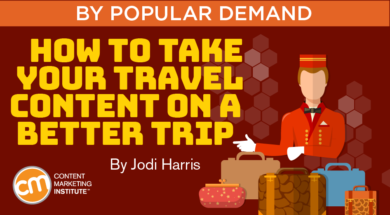 Editor’s note: In case you missed this post last year, we’re bringing it back and adding some fresh content too.
Editor’s note: In case you missed this post last year, we’re bringing it back and adding some fresh content too.
I’ve heard there are people who believe that “getting there is half the fun.” But to me, everything that happens between my decision to leave my house and my lying on a beach chair with a fruity drink in my hand is just stress-inducing static and delayed gratification.
To reduce the friction I’m likely to experience when I embark on a trip, I rely on the advice and assistance that travel experts provide online. And, judging from the sheer number of content creators who operate in this space, I’m not the only one.
With so many touchpoints to engage with, so many ways to facilitate and enhance the customer’s journey, and so many pain points your business can help them overcome, content marketing in the travel and hospitality field offers tremendous opportunities to build trust, create memorable moments, and add unique value for intrepid world explorers, road-weary business travelers, and everyone in between.
Travel and tourism content is no endless summer
Of course, as a travel industry marketer, you know your job involves a lot more than just posting some inspirational picturesque snapshots and telling tales of fun in the sun. You face significant challenges when it comes to successful storytelling in this space, not to mention plenty of competition.
Travel industry #contentmarketing requires more than picturesque snapshots and tales of fun in sun. @joderama Click To Tweet
Time and place matter – a lot
According to Andrew Davis, bestselling author of Town Inc. and host of the Travel, Tourism, and Hospitality Lab at Content Marketing World 2018, travel is one of the only industries where the place you do business matters just as much as the business you do.
Unlike the experience in industries where the digital universe has flattened the world and opened new opportunities, growth in travel and tourism depends on your business’s ability to get people out of their homes (and away from their computers) and into the physical places in which you operate.
When it comes to content, Andrew advises, focus less on what you offer as a business and more on compelling people to want to visit your location. “You’ve got to increase demand for the particular destination you serve, first and foremost,” he says.
Andrew also points out how timing and seasonality play a much bigger role in travel and tourism marketing compared to other industries. For example, while consumer product goods and other retail marketers have a consistent, primary boom time (i.e., the end-of-year holidays), travel destinations often need to focus the bulk of their marketing efforts around smaller and more location-dependent events, which can occur at any time throughout the year (think of Indio, California, which has its boom time every April during the Coachella Valley Music and Arts Festival, or a mountain resort that gets a surge in visitors during ski season).
Furthermore, every touchpoint in travel experiences is highly subject to disruption from unpredictable factors, like fluctuations in fuel prices, current travel trends, and even natural disasters. These influences can vastly impact pricing and profitability from year to year – and exponentially complicate your content marketing strategy.
Everyone is a potential competitor
From huge hotel chains to boutique B&Bs, and from tour providers to beach equipment rental providers, it seems everyone has travel information to share online. And it’s not always clear whose is the most accurate, trustworthy, or useful. Tourism and hospitality marketers need to go the extra mile when it comes to creating content that distinguishes the experiences they offer and earns bookings, not just “lookings.”
“Travel businesses don’t do enough to leverage the things that make their destinations truly unique,” says Andrew.
#Travel businesses don’t do enough to leverage what makes their destinations unique, says @DrewDavisHere. Click To Tweet
The use of beautiful photos of mountains, beaches, and attractions like roller coasters has become ubiquitous – on both travel-related sites and consumers’ websites and social channels. Little distinguishes one destination from another. Travel industry marketers are good at telling people that we’re different, but not as good at demonstrating it, he says.
You must strike a balance between inclusivity and exclusivity
While your content can (and should) communicate your destination’s universal appeal, Andrew says you can gain a greater competitive advantage by focusing on what makes your destination uniquely valuable to one audience niche – i.e., a group of people whose passions may not be equally accommodated anywhere else.
For example, in a recent video conversation, Andrew points out that Roanoke, Virginia, built its marketing and tourism strategy around making sure mountain biking aficionados believe it offers the best experience on the East Coast – right down to creating T-shirts that feature a clever spin on the state’s popular tourism slogan, Virginia Is For Lovers.
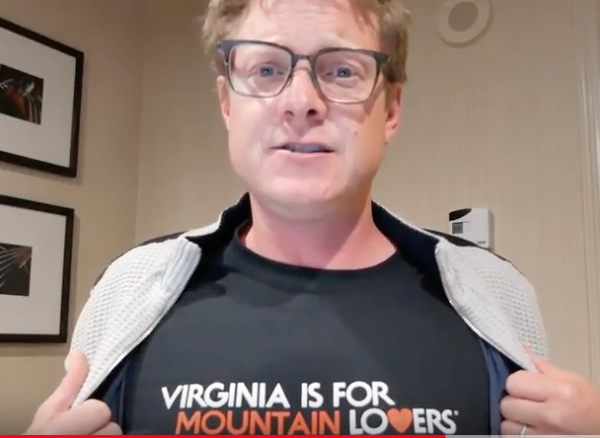
Tech raises the stakes for personalization
Deloitte’s 2018 Travel and Hospitality Industry Outlook brings up another reason it’s critical for travel brands to specialize: the latest technological advances, which enable travel marketers to create “personalized moments that matter.”
The travel industry is “on the verge of an evolutionary leap, where the relationship between customer and brand is becoming truly real-time and relevant,” according to the Deloitte report. It predicts that increased adoption of technologies like AI and machine learning, voice-response, and even cryptocurrency (and the user data they help generate) could help travel brands deliver joyful and uniquely personalized travel experiences – such as a push notification about a jazz show downtown sent to a hotel guest with a passion for live music or a special cocktail handed to a frequent business flyer as she boards her flight.
#Travel industry at “evolutionary leap” where relationship b/n customer & brand is in real time. @Deloitte Click To Tweet
HANDPICKED RELATED CONTENT:
The social ripple effect can knock you off course
In a landscape where an online review from a dissatisfied consumer or a video of a poorly handled customer service incident can speak louder than all the carefully crafted content your brand creates, you have an urgent need to monitor your online reputations carefully and respond quickly – and not just on the social channels you commonly use to communicate with your customers. For example, a single one-star review on a site like TripAdvisor can negate the favorable opinions of dozens of enthusiastic brand fans on your Facebook page.
Content opportunities in travel and tourism
Despite the significant challenges, your travel and tourism business has plenty of advantages when it comes to creating content. For one thing, your content has the power to put a world of travel experiences at the consumer’s fingertips in real and virtual settings.
The right content can make a traveler’s planning process simpler and all the steps in their physical journey easier to manage. And, beyond the practical considerations, there’s a high degree of emotional cachet up for grabs: Not only can immersive storytelling simulate the excitement of exploring a new destination, it can offer your customers an opportunity to experience their wildest travel fantasies from their desks – like the folks at Zenith Aircraft and StoryUp have done with their 360-degree virtual flight demos.
Here are a few more tips and examples on how your travel and tourism business can put content’s multipurpose power into play:
Embrace inspiration and interaction
People want travel content to inform, inspire, and entertain them throughout the dream-and-discover phase, just as they want their planning and booking requests to be accommodated. The attention earned by sharing inspiring ideas, useful information, and fun content experiences can help your business stand out when those engaged consumers are ready to book their travel.
Example: Travel Oregon – The Game
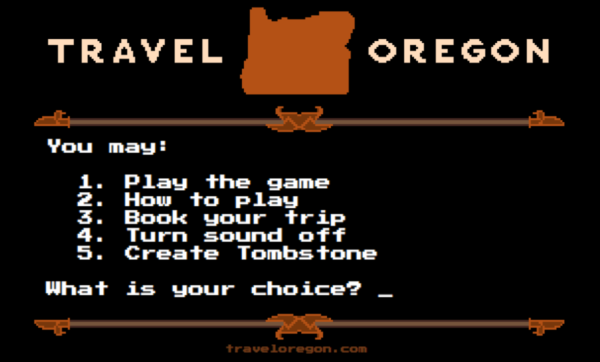
From its eight-bit graphics to its gameplay that recalls the gaming experience of the pre-internet era, this nostalgia effort captures the pioneering spirit of early Oregon settlers while promoting new tourism opportunities in the state – same gorgeous landscapes but far less dysentery. Travel Oregon – The Game proves that you don’t need fancy AR overlays, VR-enhanced graphics, or livestreaming video to create immersive storytelling.
Make adventure more manageable
The ability to virtually explore destinations from living rooms and laptops can be a powerful driver of consumer intent and action. Still, travelers need to navigate many practical decisions to make any journey (fantasy or otherwise) a success. Create content to facilitate a smoother planning process, find unique activities, or navigate their journeys with greater ease and you may earn the kind of customer appreciation and loyalty your brand can bank on.
Example: Louis Vuitton City Guide
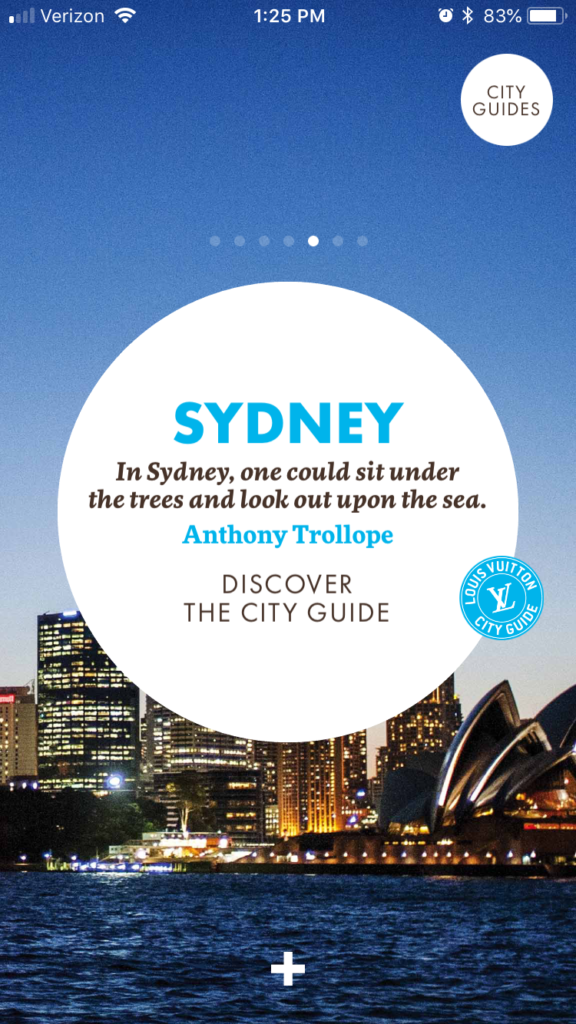
Fashion designer Louis Vuitton is probably not the first business that springs to mind when travelers plan their next vacations. But, given the caliber of the content in the brand’s City Guide app, maybe it should be – especially for those accustomed to traveling in high style.
To create the content, LV brought in regional experts known for their strong design aesthetic and gave them a platform for expressing their love of the city. Through its app, the brand offers ideas to help users elevate their travel experience in over 25 popular destinations, the ability to send digital postcards to jealous friends at home, and expert tips to help them find their footing no matter where in the world their LV luggage might accompany them.
Build experiences around the reasons customers travel
Andrew points out that people don’t book hotel rooms to motivate themselves to travel – they book them because they will be traveling. Focus your content experiences around the specific inspiration for a visit – like a business trip, a burgeoning interest in ecotourism, or a passion for world exploration – and you’ll take the first, critical step toward earning the loyalty of a niche audience that is well positioned to help your business grow.
Example: Southwest Airlines – Hudson’s Big Day
One of Southwest Airlines’s most popular content pieces is based on a customer’s interaction with the airline from a vantage point that is about as grounded as you can get: the tarmac. Airplane-loving boy Hudson received the surprise of his life when a pilot stopped his plane to wave to him through the cockpit window. Hudson’s mom posted about the exchange on Facebook, and Southwest’s social listening team ran with it. It contacted the pilot, set up a tour of the plane for the little boy and his family, and recorded the touching experience to share with the internal team and fellow aviation enthusiasts, and, according to Brooks Thomas, social business advisor for Southwest, to train new employees about the power of going the extra mile for their customers.
Involve your destination’s community
One of the core tenets Andrew encourages travel and hospitality marketers to embrace is using your content to build support for your business among your fellow community members. This requires some give and take, so it’s important to highlight, promote, and engage with local visionaries, as well as other influencers who can help increase the appeal of your destination and your business. “Ask yourself, ‘Who are the people who are painting a picture of what the future will be like in your destination; and what are you doing to spread the word, share their stories, and get valuable feedback,’” he says.
Use your #content to build support for your business among your fellow community members, says @DrewDavisHere. Click To Tweet
Example: Travelocity – Gnational Gnomads
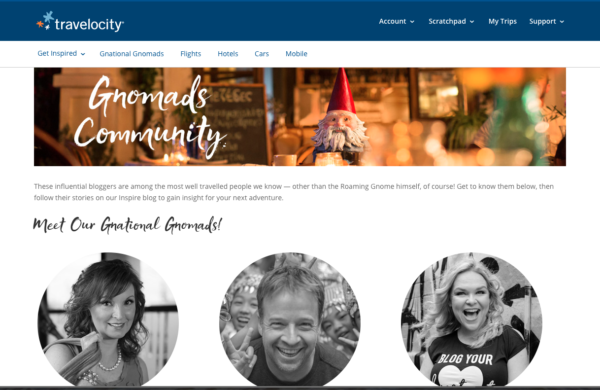
Travelocity set out to reverse the widespread perception that online travel agencies are purely transactional by creating a community of travel experts known as The Gnomads. These hand-selected national influencers champion travel by speaking to a variety of interests and travel styles, and representing diverse demographics.
Travelocity engages these influencers by giving them a direct role in storytelling, a pillar of its content marketing program. Unlike some influencer programs that require a high level of investment, Travelocity’s program pays for itself and drives revenue through its self-funded model. Gnational Gnomads are invited to visit travel destinations and document their experiences in real time via blog posts, social posts, and short-form videos. The program earned recognition as a 2017 Content Marketing Awards finalist for Best Content Marketing Program in Travel/Tourism.
Grab a souvenir before you depart
In this video, you can see more of Andrew’s lively discussion on how to use content to increase the success of your travel and tourism business.
To receive the full benefit of Andrew’s expertise, you won’t want to miss his Travel, Tourism, and Hospitality Lab at Content Marketing World 2018. This one’s going to fill up fast, so register now.
Cover image by Joseph Kalinowski/Content Marketing Institute